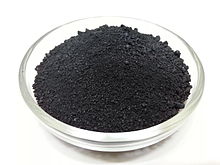Ruthenium compounds
Ruthenium compounds are compounds containing the element
Oxides and chalcogenides
Ruthenium can be
Dipotassium ruthenate (K2RuO4, +6) and potassium perruthenate (KRuO4, +7) are also known.[3] Unlike osmium tetroxide, ruthenium tetroxide is less stable, is strong enough as an oxidising agent to oxidise dilute hydrochloric acid and organic solvents like ethanol at room temperature, and is easily reduced to ruthenate (RuO2−
4) in aqueous alkaline solutions; it decomposes to form the dioxide above 100 °C. Unlike iron but like osmium, ruthenium does not form oxides in its lower +2 and +3 oxidation states.[4] Ruthenium forms dichalcogenides, which are diamagnetic semiconductors crystallizing in the pyrite structure.[4] Ruthenium sulfide (RuS2) occurs naturally as the mineral laurite.
Like iron, ruthenium does not readily form oxoanions and prefers to achieve high coordination numbers with hydroxide ions instead. Ruthenium tetroxide is reduced by cold dilute potassium hydroxide to form black potassium perruthenate, KRuO4, with ruthenium in the +7 oxidation state. Potassium perruthenate can also be produced by oxidising potassium ruthenate, K2RuO4, with chlorine gas. The perruthenate ion is unstable and is reduced by water to form the orange ruthenate. Potassium ruthenate may be synthesized by reacting ruthenium metal with molten potassium hydroxide and potassium nitrate.[5]
Some mixed oxides are also known, such as MIIRuIVO3, Na3RuVO4, Na
2RuV
2O
7, and MII
2LnIII
RuV
O
6.[5]
Halides and oxyhalides

The highest known ruthenium halide is the
Trichloride
Coordination and organometallic complexes

Ruthenium forms a variety of coordination complexes. Examples are the many pentaammine derivatives [Ru(NH3)5L]n+ that often exist for both Ru(II) and Ru(III). Derivatives of bipyridine and terpyridine are numerous, best known being the luminescent tris(bipyridine)ruthenium(II) chloride.
Ruthenium forms a wide range compounds with carbon-ruthenium bonds.
See also
- Iron compounds
- Osmium compounds
- Technetium compounds
- Rhodium compounds
References
- ^ ISBN 978-0-7514-0413-5.
- S2CID 95804621.
- ISBN 0-7506-3365-4.
- ^ a b Greenwood and Earnshaw, pp. 1080–1
- ^ a b Greenwood and Earnshaw, p. 1082
- ^ a b c Greenwood and Earnshaw, p. 1083
- ^ a b Greenwood and Earnshaw, p. 1084
- ISBN 1-891389-53-X
